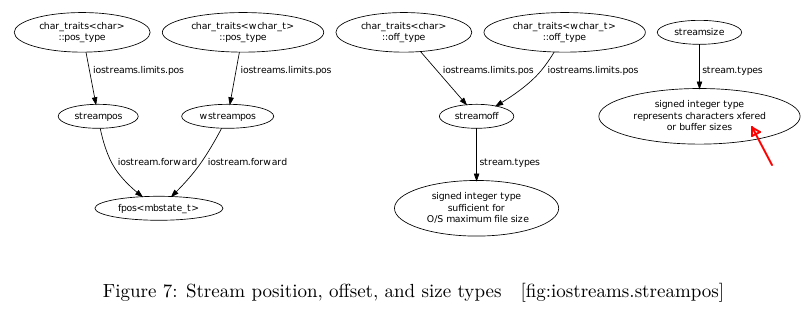New issue
Have a question about this project? Sign up for a free GitHub account to open an issue and contact its maintainers and the community.
By clicking “Sign up for GitHub”, you agree to our terms of service and privacy statement. We’ll occasionally send you account related emails.
Already on GitHub? Sign in to your account
[fig:iostreams.streampos] Reconsider use of informal term "xfered" #4246
Comments
|
Even if we like the "x", it's still misspelled, given that "transferred" has two "r"s. I'm also unhappy about the use of "O/S" for (presumably) "operating (divided by) system". Also... the arrows in this diagram don't all represent the same thing. And what are the labels on the arrows? Are those... subclause labels? Oh no, that's a maintenance nightmare. Finally, this diagram is in the overall summary of Clause 29, indicating relationships between some types defined in that Clause. But these types are not even close to being the most important types described in Clause 29; in fact, I would expect that most users of the more common Clause 29 facilities have never even heard of them and don't care about them at all. Maybe we should delete paragraph 3 entirely, along with its figure. @jwakely Would that be OK with you? Do you think that note adds value? |
|
Two more reasons to dislike this figure:
|
|
Let's delete it all, I've always found it unnecessarily difficult to find the definitions of I think adding hyperlink cross-references to [iosfwd.syn] would provide far more value than that figure. We could also add cross-references from [iostreams.limits.pos] to [iosfwd.syn] and [stream.types] for [ios.syn] has a completely redundant redeclaration of Why is [stream.types] tucked away under "Iostreams base classes" [iostreams.base] when it's not part of any class, base or not. Why is |
|
Just to add some historical context: this figure was added for C++11, despite addressing a design installed in C++98, by paper http://www.open-std.org/jtc1/sc22/wg21/docs/papers/2009/n2926.pdf at the Frankfurt 2009 meeting. At first glance there is a lot of circularity in the definition of the type aliases used by iostreams, and this diagram is intended to make it clear where the roots that others are defined in terms of can be found. I know that I have found this diagram helpful in the past, but the standard has had 10 years evolving the wording so maybe it is not as important as it used to be? I suggest we might want to review the original paper and the confusion it is intended to clear up, before deciding on the removal. I am not in a good place to evaluate, as my own understanding of this clause it tied strongly to the introduction of the diagram now, rather than the text alone. |
|
My understanding of those types is not improved by the diagram in the slightest. As Richard said above, the arrows don't always mean the same thing ... except that actually they do, the note before the diagram is a lie (the arrows always mean A is a typedef denoting the same type as B). The rightmost part adds absolutely nothing that isn't said in [stream.types]. It's an impl-defined signed integer type. Fine. We don't need a diagram to say that. Moving [stream.types] earlier in the Clause might help though. For the rest of the diagram, maybe we could add a paragraph to [iostreams.limits.pos] saying that for each of the specializations of |
|
The types Edit: sorry, they're used once each in [char.traits.specializations]. They don't need to be though, arguably it would be simpler if |
|
ISO have issued new guidelines for drawings, which would require us to provide them with the source for this figure. Although a |
|
We have a few more |
|
According to https://tex.stackexchange.com/a/2106, the |
|
SVG is fine for ISO, according to "DRG working instructions and directives". |
|
Hm, an alternative, according to the TikZ manual, is to use TikZ-in-LaTeX as the primary source, and TikZ has an output driver that generates SVG. So we could ship the exported images to ISO as SVGs. That would of course mean redrawing all the images in TikZ. |
Also add a note to [iostreams.limits.pos] to replace the removed figure. Fixes #4246.
I was pretty surprised to see this:

I realize "xfer" has long been used informally in space-constrained contexts, but it seems out of place in a formal specification.
The text was updated successfully, but these errors were encountered: